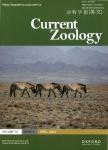Lipid reserves and immune defense in healthy and diseased migrating monarchs Danaus plexippus
Lipid reserves and immune defense in healthy and diseased migrating monarchs Danaus plexippus作者机构:Odum School of Ecology University of Georgia Athens GA 30602 USA
出 版 物:《Current Zoology》 (动物学报(英文版))
年 卷 期:2013年第59卷第3期
页 面:393-402页
核心收录:
学科分类:0710[理学-生物学] 071010[理学-生物化学与分子生物学] 07[理学] 082601[工学-武器系统与运用工程] 08[工学] 0826[工学-兵器科学与技术]
基 金:We thank M. Maudsley and M. Weath- ers for conducting PO assays and assisting with monarch cap- ture, hemocyte counts, and parasite load quantification A. Davis for analysis of morphometric wing data L. Brower, T. Maddox and the UGA Analytical Chemistry Lab for guidance and resources for lipid extractions, and the Altizer lab and two anonymous reviewers for comments on previous drafts of the manuscript. Funding for this project was provided by the Na- tional Science Foundation (grant DEB-0643831 to S.A. and a Graduate Research Fellowship to D.S.) and the UGA Inte- grated Life Science Program to D.S
主 题:Butterfly Hemocytes Migration Neogregarine Infection Energy reserves
摘 要:Recent studies suggest that the energetic demands of long-distance migration might lower the pool of resources available for costly immune defenses. Moreover, migration could amplify the costs of parasitism if animals suffering from para- site-induced damage or depleted energy reserves are less able to migrate long distances. We investigated relationships between long-distance migration, infection, and immunity in wild fall-migrating monarch butterflies Danaus plexippus. Monarchs migrate annually from eastern North America to central Mexico, accumulating lipids essential for migration and winter survival as they travel southward. Monarchs are commonly infected by the debilitating protozoan parasite Ophryocystis elektroscirrha (OE). We collected data on lipid reserves, parasite loads, and two immune measures (hemocyte concentration and phenoloxidase activity) from wild monarchs migrating through north GA (USA) to ask whether (1) parasite infection negatively affects lipid reserves, and (2) greater investment in lipid reserves is associated with lower immune measures. Results showed that monarchs sampled later in the fall migration had lower but not significantly different immune measures and significantly higher lipid reserves than those sampled earlier. Lipid measures correlated negatively but only nearly significantly with one measure of immune defense (phenoloxidase activity) in both healthy and infected monarchs, but did not depend on monarch infection status or parasite load. These results provide weak support for a trade-off between energy reserves and immune defense in migrants, and suggest that previously-demonstrated costs of OE infection for monarch migration are not caused by depleted lipid reserves .



